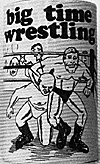
Designed by Kurt Schneible and Keith Houghton
Armadillo Press
105 Giffords Church Road,
Schenectady, NY 12306
Released: March, 1985
Price: $9.00 + $1.00 Postage and Handling
Complexity: Beginner
Solitaire Suitability: Low
* 1/2
Imagine your flesh being flailed from your bones. "What's the fun in that?" you ask. Big Time Wrestling is a card/strategy game that attempts to answer that question, claiming its combination of precise strategy and aggressive action will provide hours of fun.
Unfortunately, very few people will want to play this game for hours. The rules lack clarity and, after a while, the game becomes repetitive.
Part of the problem is the lack of diversity in the components. The map is dull and unattractive, and, when it is first unrolled, it is almost impossible to keep it from curling up. The cardboard wrestlers and the action cards are funny to look at at first glance.
The entire game is funny, with wrestlers doing moves like the nose elongator, the double flab chop, and numerous low blows. Within moments, however, the game degenerates into an exercise in laying down cards and cross-indexing.
A typical match begins with both wrestlers moving to the center of the ring and attacking. From then on, there is no reason for the wrestlers to move for the rest of the match. There are no rules for surprise attacks, attacks from behind, or cheating. Facing makes no difference to the wrestlers, so there is actually very little reason to have any rules for movement at all.
The rules are well laid out and organized, but they lack some necessary details. For instance, if a wrestler has action points left after an attack, there is no rule to say whether or not he can attack again. Also, it would have been a big help to have examples of how some of the wrestlers work. A team of midgets is allowed to have two people in the ring at a time, but there are no rules for their capitalizing on this.
In fact, there are no sure ways to use any strategy. One wrestler who uses a four-liter beer stein can win almost all of his matches. A] I the players can do is hope that they draw a great card at the right time.
The only exception to this is the tag team rules. These rules cause the players to think out every move, agonize over which card to play, and time movement in order to have the right wrestler in the ring at the right time. Unfortunately, even these rules are incomplete. There are rules for double teaming an opponent, but there is no way to get an opponent into a corner in order to double team him.
Another problem with the corners is that one of the attacks can only be done in a corner, yet it is very unlikely to get an opponent in the corner. Other minor problems plague this game. The Action Chart is only half filled in and the players have to remember to use it in the right order. The effects of this chart, which decide what damage the wrestlers take in a combat round, appear random. For instance, why does a wrestler who does an arm drag when his opponent does a Nuclear Knee Drop/Body Slam take three points of damage and his opponent take two?
Another point is that an attack done in one round will have no effect on attacks in the next round. it would seem logical that a grab in one round would make a grab or a throw in the next round easier, but there are no rules to cover that.
Big Time Wrestling is too limited and too vague; only its tag team rules give players some chance to use strategy and creativity. Armadillo Press has the beginnings of a good game here, but it needs to be cleaned up. For anyone who is desperate for a wrestling game, this will probably do. Rules can be modified and new wrestlers created in order to make the game less repetitive.
More Adult Game Reviews
- Game Review: A Question of Scruples
Game Review: Toxins
Game Review: Yellowstone
Game Review: Big Time Wrestling
Game Review: 13: The Plus-Minus Card Game
Game Review: Illuminati Expansion Set 3
Back to Table of Contents -- Game News #11
To Game News List of Issues
To MagWeb Master Magazine List
© Copyright 1986 by Dana Lombardy.
This article appears in MagWeb (Magazine Web) on the Internet World Wide Web.
Other military history articles and gaming articles are available at http://www.magweb.com